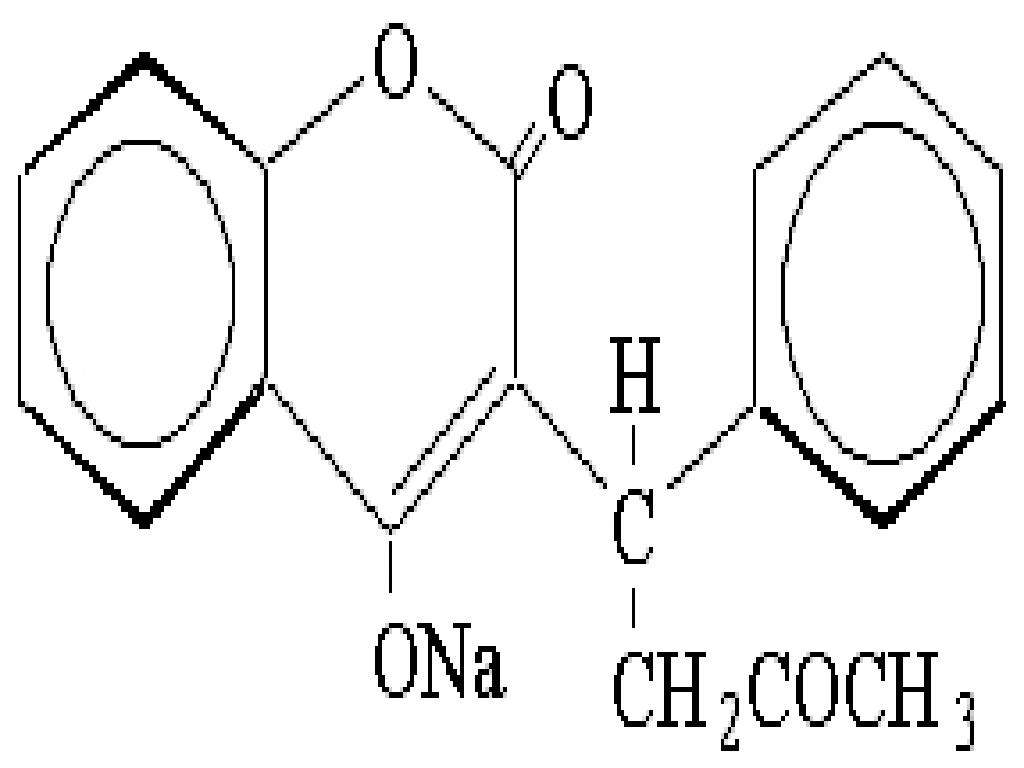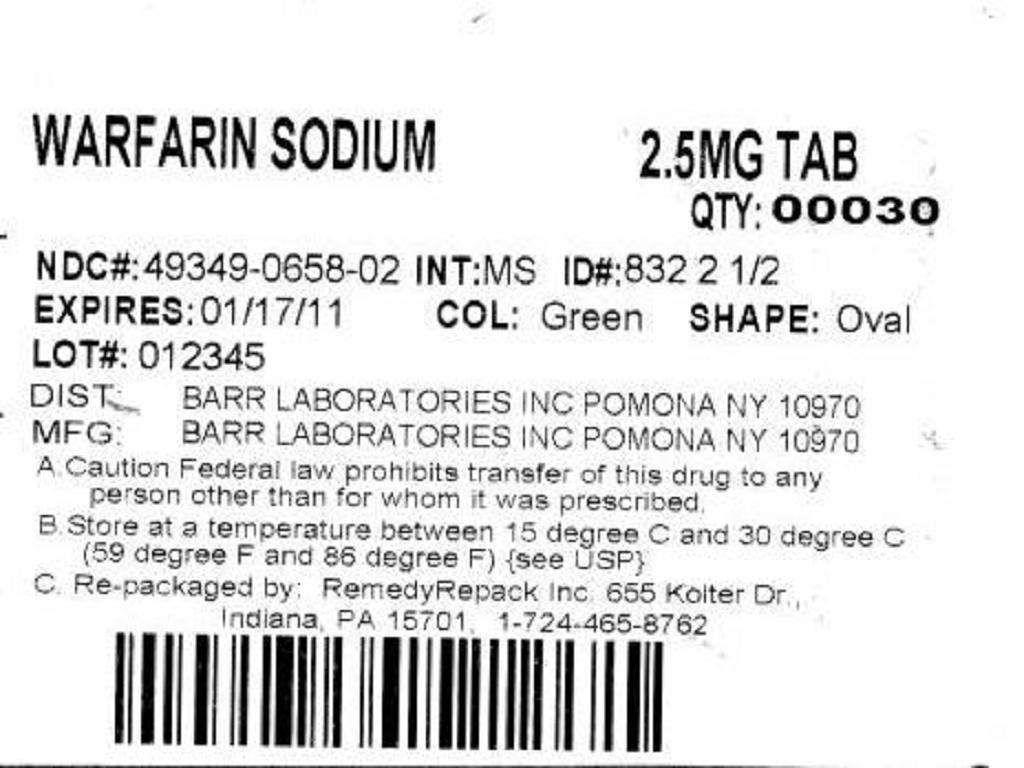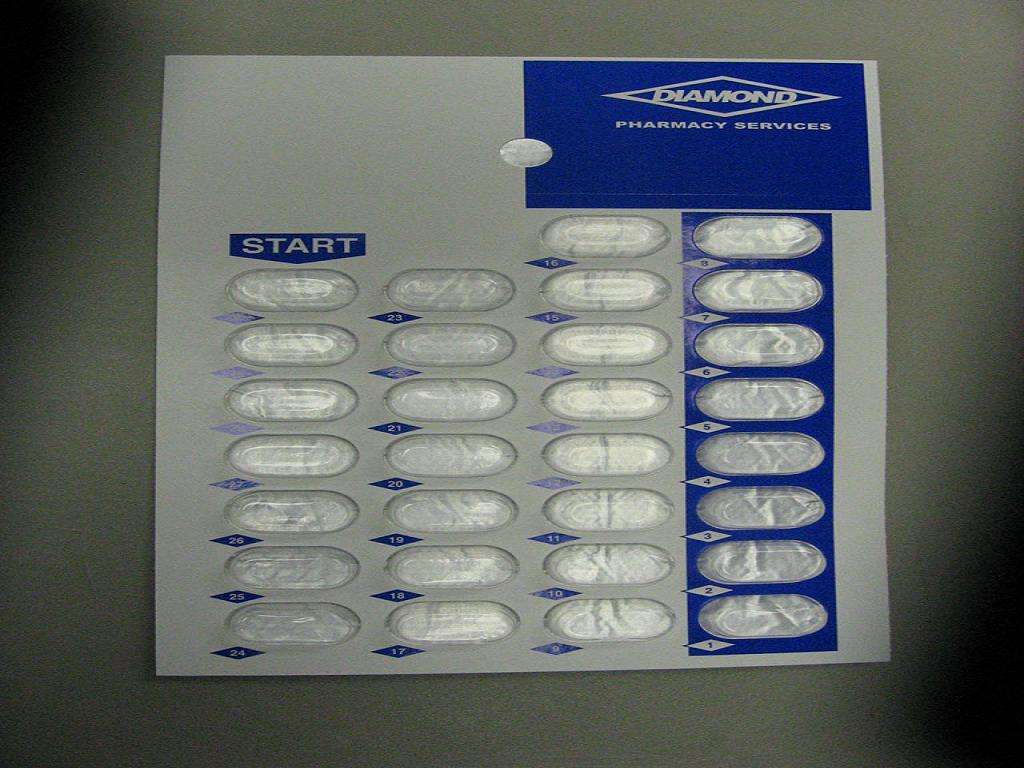Warfarin Sodium
FULL PRESCRIBING INFORMATION: CONTENTS*
- BOXED WARNING
- WARFARIN SODIUM DESCRIPTION
- CLINICAL PHARMACOLOGY
- PHARMACOKINETICS
- INDICATIONS & USAGE
- WARFARIN SODIUM CONTRAINDICATIONS
- WARNINGS
- PRECAUTIONS
- INFORMATION FOR PATIENTS
- CARCINOGENESIS & MUTAGENESIS & IMPAIRMENT OF FERTILITY
- PREGNANCY
- PEDIATRIC USE
- GERIATRIC USE
- WARFARIN SODIUM ADVERSE REACTIONS
- OVERDOSAGE
- DOSAGE & ADMINISTRATION
- HOW SUPPLIED
- REFERENCES
- SPL MEDGUIDE
- PACKAGE LABEL.PRINCIPAL DISPLAY PANEL SECTION
FULL PRESCRIBING INFORMATION
WARFARIN SODIUM DESCRIPTION

CLINICAL PHARMACOLOGY
Mechanism of Action
PHARMACOKINETICS
Absorption
Distribution
WARNINGS
Metabolism
**
Excretion
Pharmacogenomics
Elderly
Asians
Renal Dysfunction
Hepatic Dysfunction
CLINICAL TRIALS
Atrial Fibrillation (AF)
Myocardial Infarction
DOSAGE AND ADMINISTRATION
*****
Mechanical and Bioprosthetic Heart Valves
INDICATIONS & USAGE
WARFARIN SODIUM CONTRAINDICATIONS
Pregnancy
WARNINGS
PRECAUTIONS
Laboratory Control.PharmacogenomicsEndogenous Factors:
Exogenous Factors:
Botanical (Herbal) Medicines
-
● Bromelains, danshen, dong quai (Angelica sinensis), garlic, Ginkgo biloba, ginseng, and cranberry products are associated most often with an INCREASE in the effects of warfarin sodium.
-
● Coenzyme Q10 (ubidecarenone) and St. John's wort are associated most often with a DECREASE in the effects of warfarin sodium.
Effect on Other Drugs
Considerations for Increased Bleeding Risk
PharmacokineticsDOSAGE AND ADMINISTRATION
INFORMATION FOR PATIENTS
CONTRAINDICATIONSCARCINOGENESIS & MUTAGENESIS & IMPAIRMENT OF FERTILITY
CONTRAINDICATIONSPREGNANCY
CONTRAINDICATIONSPEDIATRIC USE
GERIATRIC USE
CLINICAL PHARMACOLOGYDOSAGE AND ADMINISTRATIONWARFARIN SODIUM ADVERSE REACTIONS
-
● Treatment.)
-
● Bleeding which occurs when the PT/INR is within the therapeutic range warrants diagnostic investigation since it may unmask a previously unsuspected lesion, e.g., tumor, ulcer, etc.
-
● Necrosis of skin and other tissues. (SeeWARNINGS.)
-
● Adverse reactions reported infrequently include: hypersensitivity/allergic reactions, including anaphylactic reactions, systemic cholesterol microembolization, purple toes syndrome, hepatitis, cholestatic hepatic injury, jaundice, elevated liver enzymes, hypotension, vasculitis, edema, anemia, pallor, fever, rash, dermatitis, including bullous eruptions, urticaria, angina syndrome, chest pain, abdominal pain including cramping, flatulence/bloating, fatigue, lethargy, malaise, asthenia, nausea, vomiting, diarrhea, pain, headache, dizziness, loss of consciousness, syncope, coma, taste perversion, pruritus, alopecia, cold intolerance, and paresthesia including feeling cold and chills.
OVERDOSAGE
Signs and SymptomsTreatment
DOSAGE & ADMINISTRATION
Venous Thromboembolism (including deep venous thrombosis [DVT] and pulmonary embolism [PE])
Atrial Fibrillation
Post-Myocardial Infarction
Mechanical and Bioprosthetic Heart Valves
Recurrent Systemic Embolism and Other Indications
Initial Dosage
-
● Clinical factors including age, race, body weight, sex, concomitant medications, and comorbidities and
-
● Genetic factors (CYP2C9 and VKORC1 genotypes).
Maintenance
PRECAUTIONS
Duration of Therapy
Missed Dose
Laboratory Control
PRECAUTIONS
Treatment During Dentistry and Surgery
Conversion From Heparin Therapy
-
● 5 hours after the last IV bolus dose of heparin, or
-
● 4 hours after cessation of a continuous IV infusion of heparin, or
-
● 24 hours after the last subcutaneous heparin injection.
HOW SUPPLIED
REFERENCES
SPL MEDGUIDE
MEDICATION GUIDERx only
-
● Take your Warfarin Sodium exactly as prescribed to lower the chance of blood clots forming in your body. (SeeWhat is Warfarin Sodium?)
-
● Warfarin Sodium is very important for your health, but it can cause serious and life-threatening bleeding problems. To benefit from Warfarin Sodium and also lower your chance for bleeding problems, you must:
-
● Get your regular blood test to check for your response to Warfarin Sodium. This blood test is called a PT/INR test. The PT/INR test checks to see how fast your blood clots. Your healthcare provider will decide what PT/INR numbers are best for you. Your dose of Warfarin Sodium will be adjusted to keep your PT/INR in a target range for you.
-
● Call your healthcare provider right away if you get any of the following signs or symptoms of bleeding problems:
-
● pain, swelling, or discomfort
-
● headaches, dizziness, or weakness
-
● unusual bruising (bruises that develop without known cause or grow in size)
-
● nosebleeds
-
● bleeding gums
-
● bleeding from cuts takes a long time to stop
-
● menstrual bleeding or vaginal bleeding that is heavier than normal
-
● pink or brown urine
-
● red or black stools
-
● coughing up blood
-
● vomiting blood or material that looks like coffee grounds
-
● Many other medicines, including prescription and non-prescription medicines, vitamins, and herbal supplements can interact with Warfarin Sodium and:
-
● affect the dose you need, or
-
● increase Warfarin Sodium side effects.
-
● Do not take other medicines that contain warfarin. Warfarin is the active ingredient in Warfarin Sodium Tablets.
-
● Some foods can interact with Warfarin Sodium and affect your treatment and dose.
-
● Eat a normal, balanced diet. Talk to your doctor before you make any diet changes. Do not eat large amounts of leafy green vegetables. Leafy green vegetables contain vitamin K. Certain vegetable oils also contain large amounts of vitamin K. Too much vitamin K can lower the effect of Warfarin Sodium.
-
● Avoid drinking cranberry juice or eating cranberry products.
-
● Avoid drinking alcohol.
-
● Always tell all of your healthcare providers that you take Warfarin Sodium.
-
● Wear or carry information that you take Warfarin Sodium.
-
● your chance of having bleeding problems is higher than the possible benefit of treatment. Your healthcare provider will decide if Warfarin Sodium is right for you. Talk to your healthcare provider about all of your health conditions.
-
● you are pregnant or plan to become pregnant. Warfarin Sodium can cause death or birth defects to an unborn baby. Use effective birth control if you can get pregnant.
-
● you are allergic to warfarin or to anything else in Warfarin Sodium Tablets.
-
● have bleeding problems
-
● fall often
-
● have liver or kidney problems
-
● have high blood pressure
-
● have a heart problem called congestive heart failure
-
● have diabetes
-
● drink alcohol or have problems with alcohol abuse. Alcohol can affect your Warfarin Sodium dose and should be avoided.
-
● are pregnant or planning to become pregnant. SeeWho should not take Warfarin Sodium?
-
● are breast-feeding. Warfarin Sodium may increase bleeding in your baby. Talk to your doctor about the best way to feed your baby. If you choose to breast-feed while taking Warfarin Sodium, both you and your baby should be carefully monitored for bleeding problems.
-
● Tell your healthcare provider about all the medicines you take including prescription and non-prescription medicines, vitamins, and herbal supplements. SeeWhat is the most important information I should know about Warfarin Sodium?
-
● Take Warfarin Sodium exactly as prescribed. Your healthcare provider will adjust your dose from time to time depending on your response to Warfarin Sodium.
-
● You must have regular blood tests and visits with your healthcare provider to monitor your condition.
-
● Take Warfarin Sodium at the same time every day. You can take Warfarin Sodium either with food or on an empty stomach.
-
● If you miss a dose of Warfarin Sodium, call your healthcare provider. Take the dose as soon as possible on the same day. Do not take a double dose of Warfarin Sodium the next day to make up for a missed dose.
-
● Call your healthcare provider right away if you take too much Warfarin Sodium.
-
● Call your healthcare provider if you are sick with diarrhea, an infection, or have a fever.
-
● Tell your healthcare provider about any planned surgeries, medical or dental procedures. Your Warfarin Sodium may have to be stopped for a short time or you may need your dose adjusted.
-
● Call your healthcare provider right away if you fall or injure yourself, especially if you hit your head. Your healthcare provider may need to check you.
What should I avoid while taking Warfarin Sodium?
-
● Do not start, stop, or change any medicine without talking with your healthcare provider.
-
● Do not make changes in your diet, such as eating large amounts of green, leafy vegetables.
-
● Do not change your weight by dieting, without first checking with your healthcare provider.
-
● Avoid drinking alcohol.
-
● Do not do any activity or sport that may cause a serious injury.
-
● Warfarin Sodium is very important for your health, but it can cause serious and life-threatening bleeding problems. SeeWhat is the most important information I should know about Warfarin Sodium?
-
● Serious side effects of Warfarin Sodium also include:
-
● death of skin tissue (skin necrosis or gangrene). This can happen soon after starting Warfarin Sodium. It happens because blood clots form and block blood flow to an area of your body. Call your healthcare provider right away if you have pain, color, or temperature change to any area of your body. You may need medical care right away to prevent death or loss (amputation) of your affected body part.
-
● purple toes syndrome.Call your healthcare provider right away if you have pain in your toes and they look purple in color or dark in color.
-
● Store at 20to 25(68to 77[See USP Controlled Room Temperature]. Protect from light.
-
● Keep Warfarin Sodium and all medicines out of the reach of children.
PACKAGE LABEL.PRINCIPAL DISPLAY PANEL SECTION


Warfarin SodiumWarfarin Sodium TABLET
| ||||||||||||||||||||||||||||||||||||||||||||||||||||||||||||||||||||||||||||||
PLEASE, BE CAREFUL!
Be sure to consult your doctor before taking any medication!